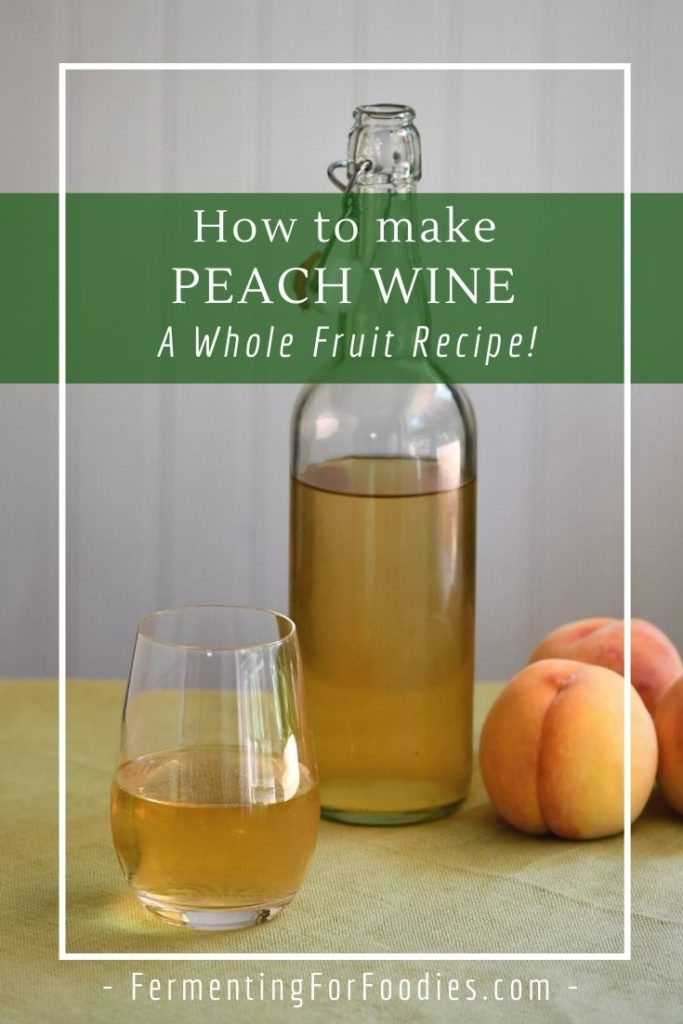To make peach wine the old-fashioned way, mash ripe peaches and ferment with sugar, water, and yeast. Strain and bottle after fermentation.
Peach wine, a delightful and refreshing beverage, has been cherished for centuries. This homemade wine captures the essence of ripe, juicy peaches, offering a taste of summer in every sip. Making peach wine the old-fashioned way involves simple, natural ingredients and traditional techniques.
The process starts with selecting the ripest peaches, ensuring optimal sweetness and flavor. After mashing the peaches, combine them with sugar, water, and yeast to start fermentation. This method of winemaking is not only rewarding but also allows for customization in sweetness and strength. Enjoy the satisfaction of creating a delicious, homemade peach wine that can be shared with friends and family.

Introduction To Peach Wine
Peach wine is a delightful, fruity beverage. It offers a burst of sweet flavors. Making peach wine the old-fashioned way is a rewarding experience. It connects us to traditions and history. This blog post will guide you through the fascinating world of peach wine.
History And Tradition
Peach wine has deep roots in history. Ancient civilizations cherished peaches for their sweet flavor. They often fermented peaches to create wine. This practice has continued for centuries. People passed down recipes from generation to generation.
In the past, families gathered during peach season. They picked ripe peaches and started the winemaking process. This tradition brought communities together. It was a time of sharing stories and creating memories.
Why Choose Peach Wine
Peach wine stands out for its unique taste. The fruity flavor is refreshing and sweet. It is perfect for warm summer days. Peach wine can be enjoyed on its own or with meals.
| Reasons to Choose Peach Wine |
|---|
| Flavor: Sweet and fruity |
| Aroma: Inviting and fresh |
| Versatility: Pairs well with various dishes |
Peach wine also has health benefits. Peaches are rich in vitamins and antioxidants. This can boost your immune system. Drinking peach wine in moderation can be a part of a healthy lifestyle.

Selecting The Right Peaches
Choosing the right peaches is the first step to making delicious peach wine. Your wine’s flavor and aroma depend on the quality of the peaches. Let’s explore the best varieties and how to pick ripe peaches.
Best Varieties
Different peach varieties offer unique flavors. Here are some of the best:
- Elberta: Known for its sweet taste and firm texture.
- Red Haven: Offers a balanced sweet and tart flavor.
- Georgia Belle: Famous for its juicy and aromatic qualities.
How To Pick Ripe Peaches
Ripe peaches are essential for making flavorful wine. Use these tips to pick the best peaches:
- Check the Color: Ripe peaches have a deep golden yellow color.
- Feel the Firmness: They should be slightly soft, not mushy.
- Smell the Aroma: A strong, sweet aroma indicates ripeness.
Using the right peaches ensures your wine tastes perfect. Happy winemaking!
Preparing The Peaches
Getting the peaches ready is a crucial step in making peach wine. This involves cleaning, cutting, and removing pits. Proper preparation ensures a smooth fermentation process and a delightful final product.
Cleaning And Cutting
Start by washing the peaches under cold running water. This removes any dirt and pesticides. Use a gentle brush to scrub the surface. Make sure the peaches are thoroughly clean.
Place the peaches on a clean cutting board. Use a sharp knife to cut each peach in half. Cut along the natural crease of the peach for easy splitting. After halving, cut the peaches into smaller pieces. Smaller pieces help in better fermentation.
Removing Pits
Use a spoon or your fingers to remove the pits. Be careful not to damage the peach flesh. Pits can affect the wine’s flavor if left in. Place the pit-free peach pieces into a large bowl. The bowl should be clean and dry.
Ensure no pit fragments remain. Check each piece thoroughly. Any leftover pit bits can spoil the wine. Once all pits are removed, the peaches are ready for the next step.
| Step | Action |
|---|---|
| 1 | Wash the peaches under cold water |
| 2 | Cut peaches in half along the crease |
| 3 | Remove pits carefully |
| 4 | Cut peaches into smaller pieces |
Fermentation Process
Making peach wine the old-fashioned way involves a key step: fermentation. This process transforms the sugars in the peaches into alcohol. It requires the right tools and ingredients. Here’s a guide on how to do it.
Choosing The Yeast
Yeast is crucial for the fermentation process. Different yeasts bring different flavors. For peach wine, you’ll want a yeast that enhances the fruit’s natural sweetness.
- Wine yeast: This is the best option for making wine. It produces the right amount of alcohol and brings out the peach flavor.
- Bread yeast: Avoid using this. It doesn’t work well with fruit wines.
Lalvin EC-1118 is a popular choice. It is robust and works well with peaches. Make sure to follow the package instructions for best results.
Fermentation Vessels
Choosing the right fermentation vessel is important. The vessel will affect the wine’s flavor and clarity. Here are some options:
| Type | Description | Pros | Cons |
|---|---|---|---|
| Glass Carboy | A large glass container for fermentation. |
|
|
| Plastic Fermenter | A lightweight and durable container. |
|
|
Make sure your vessel has an airlock. This prevents contamination while allowing gases to escape.
Aging And Bottling
Aging and bottling are crucial steps in making delicious peach wine. These steps ensure your wine develops complex flavors. Proper aging and bottling also prevent spoilage. Here’s how you can master these steps.
Aging Techniques
Aging peach wine allows flavors to meld and mature. This step enhances the wine’s complexity. Here are some common aging techniques:
- Glass Carboys: These are popular for aging wine. Glass does not react with the wine, preserving its taste.
- Oak Barrels: Oak barrels add unique flavors. They infuse the wine with vanilla, spice, and smoky notes.
- Stainless Steel Tanks: These tanks are ideal for a clean taste. They are easy to sanitize and maintain.
Bottling Tips
Bottling is the final step in the winemaking process. It’s vital for maintaining the wine’s quality. Here are some expert tips for bottling your peach wine:
- Clean Bottles: Always use sterilized bottles. This prevents contamination and spoilage.
- Proper Filling: Fill bottles leaving an inch of space at the top. This space is necessary for cork expansion.
- Use Quality Corks: Invest in high-quality corks. They seal the bottle well and allow minimal air exchange.
- Store Upright: Store freshly bottled wine upright for a few days. This ensures the corks seal properly.
- Labeling: Label each bottle with the date and type of wine. This helps in tracking the aging process.
Following these tips ensures your peach wine is delicious and well-preserved. Enjoy the fruits of your labor with every sip!
Common Issues And Solutions
Making peach wine the old-fashioned way can be a rewarding experience. Yet, it comes with its fair share of challenges. From preventing oxidation to troubleshooting fermentation, each step requires careful attention. Here, we cover some common issues and their solutions.
Preventing Oxidation
Oxidation can ruin your peach wine. It makes it taste stale and lifeless. To prevent this, follow these tips:
- Use Airlocks: Always use airlocks to seal your fermenter.
- Minimize Air Exposure: Transfer wine quickly between containers.
- Use Antioxidants: Add sulfites to your wine to protect it.
Avoid letting air touch your wine. This keeps it fresh and tasty.
Troubleshooting Fermentation
Fermentation issues can halt your wine-making process. Here are some common problems and their solutions:
| Issue | Possible Cause | Solution |
|---|---|---|
| No Fermentation | Inactive Yeast | Check yeast expiration date. Use fresh yeast. |
| Slow Fermentation | Low Temperature | Keep the fermenter in a warmer place. |
| Stuck Fermentation | Lack of Nutrients | Add yeast nutrients to restart fermentation. |
Address these issues promptly to ensure smooth fermentation. Keep an eye on temperature and yeast activity.
Enhancing Flavor
Enhancing the flavor of peach wine transforms the drink into something special. Simple methods bring out the best in your homemade wine. Here are some tips to elevate your peach wine.
Adding Spices
Spices add warmth and depth to peach wine. Consider adding a cinnamon stick to the fermenting process. It blends well with the sweetness of peaches. Cloves are another great option. They introduce a hint of spice and complexity.
Use spices sparingly. A little goes a long way. Start with small amounts and adjust to taste. Too much spice can overpower the delicate peach flavor.
Blending With Other Fruits
Blending peaches with other fruits creates unique flavors. Here are some great options:
- Strawberries: Adds a sweet and tangy note.
- Raspberries: Provides a tart and vibrant taste.
- Apples: Gives a crisp and fresh finish.
Experiment with different fruit combinations. Each mix will offer a new tasting experience. Keep the fruit ratios balanced. This ensures the peach flavor remains prominent.
| Fruit | Flavor Profile |
|---|---|
| Strawberries | Sweet and tangy |
| Raspberries | Tart and vibrant |
| Apples | Crisp and fresh |
Use fresh, ripe fruits for the best results. Overripe or underripe fruits can affect the final taste.

Enjoying Your Peach Wine
Now that you have made your peach wine, it’s time to enjoy it. Savoring your homemade wine is a delightful experience. Here are some tips on how to serve and pair your peach wine for the best experience.
Serving Suggestions
Peach wine can be served chilled or at room temperature. For a refreshing taste, chill the wine in the refrigerator for a few hours before serving. Use wine glasses to enhance the aroma and flavor.
Consider using a decanter to aerate your peach wine. This helps to release its fruity notes. A proper glass can make a big difference. Choose a glass with a wide bowl to allow the wine to breathe.
| Serving Temperature | Glass Type |
|---|---|
| Chilled (45-50°F) | Wide bowl glass |
| Room Temperature (60-65°F) | Standard wine glass |
Pairing With Food
Pairing your peach wine with the right food can enhance its taste. Here are some ideas:
- Cheese: Soft cheeses like Brie or goat cheese.
- Fruits: Fresh fruits such as strawberries, grapes, and apples.
- Desserts: Light desserts like fruit tarts or peach cobbler.
- Seafood: Grilled shrimp or scallops.
Peach wine also pairs well with light salads. Try a spinach salad with nuts and a light vinaigrette. For an elegant touch, serve it alongside a charcuterie board.
Enjoy your homemade peach wine with good company. The wine’s sweet and fruity notes create a memorable experience.
Frequently Asked Questions
What Ingredients Are Needed For Peach Wine?
To make peach wine, you’ll need fresh peaches, sugar, water, yeast, and lemon juice. Quality ingredients ensure the best flavor.
How Long Does It Take To Ferment Peach Wine?
Peach wine typically ferments in about 4 to 6 weeks. Patience is key to achieving the best flavor.
Can I Use Canned Peaches For Peach Wine?
Fresh peaches are recommended for the best flavor. Canned peaches can be used, but they may affect taste.
What Equipment Is Needed For Making Peach Wine?
You’ll need a fermentation vessel, airlock, siphon, and bottles. Basic winemaking equipment ensures a smooth process.
Conclusion
Crafting peach wine the old-fashioned way is a rewarding experience. It connects you to timeless traditions. By following these steps, you can create a delightful, homemade beverage. Enjoy the rich flavors and the satisfaction of your own creation. Share your peach wine with friends and family for a truly special treat.
